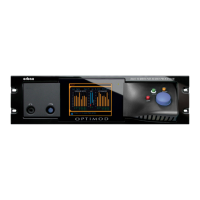OPTIMOD SURROUND PROCESSOR INTRODUCTION
1-1
Section 1
Introduction
Crucial Information—Please Read!
To make automatic loudness control as straightforward and dependable as possible,
the 8685 operates somewhat differently from other Optimods.
• Dialnorm: The 8685 works very easily with Dolby Digital® transmission systems
if you do one crucial thing: You must tell the 8685 what value of Dolby Digital
Dialnorm metadata you are transmitting to your audience. This will prevent your
transmission from being too loud or quiet compared to other correctly set up
Dolby Digital transmissions.
• The 8685’s Quick Setup
wizard (page 2- 8) leads you through the process of set-
ting Dialnorm on the 8685. Step 10 on page 2-14 explains how the 8685 uses its
knowledge of transmitted Dialnorm to control loudness.
• Your Dolby Digital transmission’s loudness will automatically be correct if:
• you use a “TV” factory preset (Table 3-1 on page 3-27),
• you
have adjusted the 8685’s input reference level so that the processing op-
erates with normal amounts of gain reduction (step 7 on page 2-11 or step 7
on page 2-25), and
• you
have adjusted the 8685’s Dialnorm to match the Dialnorm you are trans-
mitting (step 10 on page 2-14 or step 13 on page 2-34).
The 8685’s DIALNORM value can be set in two places: There is a global set-
ting in the active Setup, which can be overridden by a setting in the ac-
tive processing preset. Except for the 2.0 parameters in the analog TV
presets, all factory processing presets are configured to use the global
Dialnorm setting specified in the active Setup.
You can use the 8685’s RS-485 serial ports (serial ports #2 and #3 on the
back panel) to convey D
IALNORM to the Dolby-Encoder automatically. See
Conveying Metadata on page 2-15.
• Setting Output Loudness: To set the 8685’s output loudness, adjust its
D
IALNORM value or adjust the MB LIMITER DRIVE control in the active processing
preset. Both methods cause 8685’s O
UTPUT LEVEL meter indication to change.

